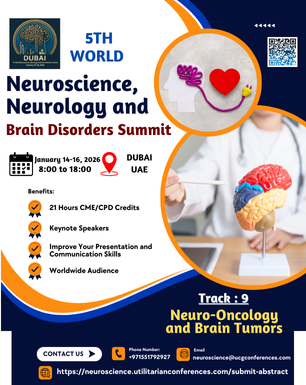



Sub Topics: Molecular and Cellular Neuroscience, Cognitive Neuroscience,...

Sub Tracks Clinical Neurology, Neurodegenerative...

Sub-Tracks Introduction to
Neuro-Oncology, Types of Brain Tumors, Epidemiology of Brain Tumors, Symptoms
of Brain Tumors,Diagnosis of Brain Tumors, Grading and Staging of Brain
Tumors,Treatment of Brain Tumors, Pediatric Brain Tumor
Neuro-Oncology
and Brain Tumors
Neuro-oncology is a
specialized branch of medicine focusing on the diagnosis, treatment, and
research of tumors that affect the nervous system, primarily the brain and
spinal cord. Brain tumors can be benign (non-cancerous) or malignant
(cancerous) and can arise from different types of brain cells, leading to
various symptoms and challenges in diagnosis and treatment.
1. Types of Brain Tumors
Brain tumors can be classified into primary (originating in the
brain) and metastatic (spread from other parts of the body).
Primary Brain Tumors:
Gliomas: Tumors originating from glial cells. These include:
Astrocytomas (including glioblastomas, the most aggressive
form),
Oligodendrogliomas,
Ependymomas.
Meningiomas: Tumors that develop from the meninges, the
protective layers surrounding the brain and spinal cord. Most meningiomas are
benign.
Medulloblastomas: Common in children, these are fast-growing
tumors originating in the cerebellum.
Pituitary Tumors: These tumors affect the pituitary gland,
which regulates hormone production.
Craniopharyngiomas: Benign tumors near the pituitary gland.
Pineal Tumors: These affect the pineal gland, responsible
for regulating sleep-wake cycles.
Metastatic Brain Tumors:
Secondary brain tumors that have spread from cancers of
other organs such as lung cancer, breast cancer, melanoma, and kidney cancer.
2. Symptoms of Brain Tumors
Symptoms vary depending on the tumor’s location, size, and type but
often include:
Headaches (especially if they worsen over time),
Seizures (new onset or changes in patterns of existing seizures),
Nausea and vomiting (often in the morning),
Cognitive and personality changes, including memory loss and
confusion,
Motor or sensory deficits, such as weakness, numbness, or
difficulty walking,
Vision changes, including blurred vision or double vision,
Speech difficulties,
Balance problems.
3. Diagnosis of Brain Tumors
Diagnosing brain tumors involves several methods:
Neurological Exam: A thorough assessment of cognitive
function, reflexes, and motor skills.
Imaging:
MRI (Magnetic Resonance Imaging): The most effective imaging
technique for detecting brain tumors and assessing their size and location.
CT Scan (Computed Tomography): Used in emergencies or when
MRI is unavailable.
PET Scan (Positron Emission Tomography): Helps in
identifying tumor activity and monitoring treatment response.
Biopsy: A surgical procedure to remove a sample of the tumor
for histopathological analysis.
Genetic Testing: Identifying specific mutations in tumor
cells can guide treatment decisions (e.g., for glioblastomas).
EEG (Electroencephalogram): Used to monitor brain electrical
activity, especially in patients with seizures.
4. Grading and Staging of Brain Tumors
Grading: The World Health Organization (WHO) classifies tumors
from Grade I (benign) to Grade IV (highly malignant), based on their appearance
under a microscope and their potential to spread.
Grade I: Benign and slow-growing (e.g., pilocytic
astrocytoma).
Grade II: Low-grade tumors that may grow slowly but can
infiltrate surrounding tissues (e.g., diffuse astrocytoma).
Grade III: Malignant tumors that grow more quickly and can
invade surrounding tissues (e.g., anaplastic astrocytoma).
Grade IV: Highly malignant and aggressive tumors (e.g.,
glioblastoma multiforme).
Staging: Brain tumor staging is not as widely used as in
other cancers due to the complexity of brain structure and the difficulty in
applying traditional staging systems. However, the tumor’s size, location, and
spread are assessed.
5. Treatment of Brain Tumors
Treatment strategies depend on the tumor type, location, size, and
grade, as well as the patient’s age and overall health.
Surgery: The primary treatment for accessible tumors is surgical resection,
aiming to remove as much of the tumor as possible without damaging vital brain
areas.
Stereotactic Surgery: Minimally invasive procedures like
biopsy or tumor resection using computer guidance for precision.
Radiotherapy:
External Beam Radiation: Delivers high-energy radiation to
shrink or eliminate tumor cells.
Stereotactic Radiosurgery: A focused, high-dose radiation
treatment (e.g., Gamma Knife, CyberKnife) for smaller tumors or residual tumor
tissue.
Chemotherapy:
Common drugs include temozolomide for glioblastomas and
carboplatin for pediatric medulloblastomas.
Newer targeted therapies focus on specific molecular changes
in tumor cells (e.g., EGFR inhibitors for glioblastomas).
Immunotherapy: Emerging treatments that harness the body’s immune system
to fight tumors, such as checkpoint inhibitors or vaccines.
Hormonal Therapy: Used for tumors affecting the pituitary gland or
other hormone-producing areas.
Clinical Trials: Ongoing research into innovative treatments like
gene therapy, oncolytic viruses, or advanced immunotherapies.
6. Prognosis of Brain Tumors
The prognosis depends on factors such as tumor type, grade,
size, location, age of the patient, and how much of the tumor can be removed
surgically.
Glioblastoma: A highly malignant tumor with a poor
prognosis, often with an average survival of 12-15 months.
Low-Grade Gliomas: These tumors tend to have a better
prognosis, with long-term survival rates depending on tumor type and treatment
response.
Meningiomas: Usually benign and can often be removed
surgically with a good prognosis.
Survival Rates: These vary widely; for example, the 5-year
survival rate for glioblastoma is around 5%, while for other lower-grade
tumors, it can exceed 70%.
7. Pediatric Brain Tumors
Brain tumors in children differ in terms of type, treatment
approaches, and outcomes. Common pediatric brain tumors include:
Medulloblastomas: Malignant tumors that develop in the
cerebellum.
Brainstem Gliomas: Tumors located in the brainstem, often
difficult to treat.
Craniopharyngiomas: Benign tumors near the pituitary gland,
affecting growth and hormonal function.
Treatment is more delicate in children due to their developing brains, and it requires a balance of effective tumor control with minimizing long-term cognitive, emotional, and physical effects.